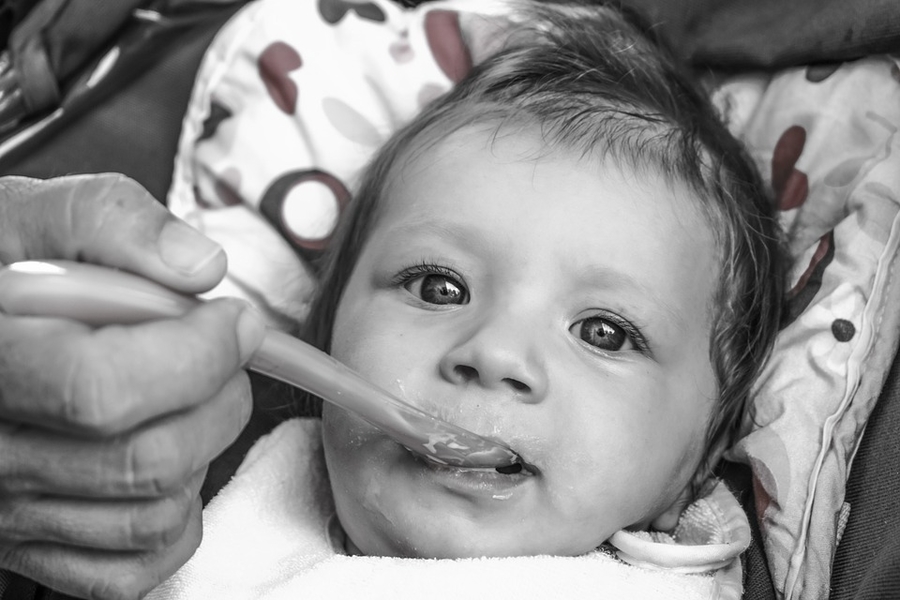
Recommended Meal Portions For Toddlers Upto 2 years
26 Feb 2018 | 5 min Read
Babychakra
Author | 1369 Articles
As the child grows, the meal compostion and portion sizes for children change.

A newborn baby should be exclusively breastfed for the first 6 months, after which he or she can be introduced to semi- solid foods. Breast-feeding along with solid or semi-solid food (complementary feeding) should be continued till 2 years of age. As the child grows, you can understand the changing requirement of the meal portion sizes for kids using the food pyramid.
Food portions for infants (0-6 months)
From birth till six months of age, exclusive breastfeeding is a must and should be practiced unless there is some unavoidable reason. The energy and protein content of the mother’s milk solely are sufficient enough to meet all nutritional requirements of the baby during the first 6 months of life. No other food or fluids are required to be given to the infant below six months of age, unless medically necessary.
In the first 2-3 days after delivery, a thick, yellow milk called colostrum is secreted in the breast milk. This has a high concentration of protective immunoglobulins and cells, which should be fed to newborn and not discarded. Prelacteal feeding i.e. giving fluids other than breast milk within the first three days of birth should be strictly avoided.
Breastfeeding confers numerous advantages to both the mother and child,. In case of working mothers, breast milk can be expressed for feeding. Relactation should be attempted in case lactation was temporarily stopped for any reason.
Portion size : Weaning baby more than 6 months of age
After completion of six months of age, complementary foods should be added to the diet of an infant, and breastfeeding should be continued for a minimum for 2 years of age. The composition and quantity of the food that toddler should be given varies as the child grows and is detailed below.
Baby food portion size for the age of 6 -8 months
As per WHO, the energy needed by a 6-8 months old infant, apart from that received from breast milk is 200 calories per day. Details of food, its texture, frequency and average amount to be consumed by a child are illustrated in the diagram below.

Recommended food includes:
Iron-rich pureed meats, fruits, and vegetables like carrots, squash, pears, bananas, green peas, sweet potatoes, etc. It is suggested that vegetables should be introduced before fruits as fruit sweetness can make vegetables less appealing.
Solid food portions for babies:
How much solid food can be given to a baby depends on the child’s control over the mouth. Hence, the mixture should be thickened gradually as baby develops greater control over the mouth. It is best to not mix food textures at this stage and ensure that the entire meal is of the same texture.
Baby food portion size (9-11 months of age)

WHO recommends a daily energy intake of 300 calories by a 9-11 month old infant, apart from that received from breast milk. The details of food that can be consumed by an infant in this age group are illustrated in the diagram below.

As your baby grows, you can introduce more variety in his meals. For this age, baby food portions should include finger foods like soft cooked vegetables, washed and peeled fruits, and noodles. Teething foods can be added to provide relief to the teething child. These include teething biscuits, unsalted crackers and bagels etc.
You can thicken the consistency of food to lumpy, thicker meals, while continuing to breast feed. Gradually, chopped bite-sized foods can be introduced. Ensure that food that can potentially cause choking (seeds, round candies, apple chunks, grapes, peannut butter, raisins, dry flake cereals) is avoided.
Baby food portion size for 12-23 months of age
As per WHO, energy needed per day by a 1-2 year-old infant, apart from that received from breast milk is 550 calories. Details of food, its texture, frequency and average amount to be consumed by a child are as follows:

Bottle feeding should be avoided as far as possible and if unavoidable, gradually replaced by cup at the earliest. By age 1, most children are off the bottle. If your child still uses a bottle, it should contain water only.
You can offer small amounts of cheese, cottage cheese, and yogurt, but no cow’s milk. Small amount of these milk products can be given 3 to 4 times per week. Some babies are sensitive to egg whites and hence, it is generally recommended to not offer them any uptil age 1.
Diet at 2 years of age
Diet at 2 years of age should include breads and grains, proteins, fruits and vegetables, and dairy. The diet should be moderately low in fat.
Calcium supplementation can be done by adding low-fat or nonfat milk, yogurt, and cheese, cooked greens and canned salmon (with bones) to the diet.
A


Related Topics for you
Suggestions offered by doctors on BabyChakra are of advisory nature i.e., for educational and informational purposes only. Content posted on, created for, or compiled by BabyChakra is not intended or designed to replace your doctor's independent judgment about any symptom, condition, or the appropriateness or risks of a procedure or treatment for a given person.
